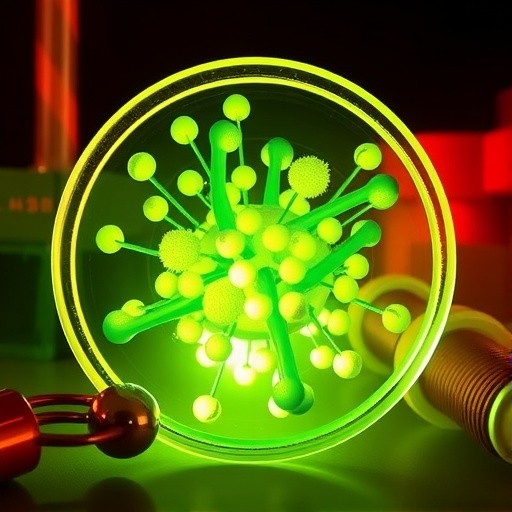
Recent advancements in bioelectrochemical applications have opened new avenues in renewable energy generation, particularly through the innovative use of microbial fuel cells (MFCs). A groundbreaking study by Pérez-García et al. introduces the bioelectrochemical potential of a pigment derived from the less-studied species of bacteria, F. uniseptata, expanding the frontiers of sustainable energy technology. This research illustrates how a natural pigment can enhance the performance of microbial fuel cells, potentially paving the way for more efficient and eco-friendly electricity generation methods.
The research dives deep into the relationship between microbial systems and electricity production, highlighting the role of biochemicals in facilitating energy conversion processes. The pigment from F. uniseptata has shown promise not only for its vibrant coloration but also for its capabilities in electron transfer processes, which can significantly amplify the output of microbial fuel cells. This dual functionality of the pigment marks a critical step in exploring alternative renewable energy resources that minimize environmental impact while maximizing energy production.
Microbial fuel cells are based on the principle of converting biochemical energy into electrical energy through the metabolic activity of microorganisms. The presence of an effective mediator, such as the pigment derived from F. uniseptata, can streamline this conversion process. The study outlines how the pigment enhances the electron transfer rate between the microbial cells and the anode, leading to improved energy yield. This represents a significant advancement in the understanding of microbial electrochemistry, showcasing the importance of selecting appropriate biocompatible materials to optimize energy outcomes.
.adsslot_dSVJtbmkfv{width:728px !important;height:90px !important;}
@media(max-width:1199px){ .adsslot_dSVJtbmkfv{width:468px !important;height:60px !important;}
}
@media(max-width:767px){ .adsslot_dSVJtbmkfv{width:320px !important;height:50px !important;}
}
ADVERTISEMENT
As researchers continue to explore ways to harness microbial processes for energy, the findings regarding F. uniseptata offer insights that could revolutionize the current methodologies employed in the energy sector. Notably, this bacterium thrives in various environments, suggesting that its pigment could be sourced sustainably while carrying minimal ecological footprint. As society grapples with the urgent need for cleaner energy solutions, this study underscores the potential for microorganisms to be harnessed as bio-factories in the quest for renewable energy.
The methodology adopted by Pérez-García and colleagues involved a systematic investigation of the pigment’s electrochemical properties, assessing its effectiveness in mediating electron transfer. The experimental setup included varying concentrations of the pigment in controlled conditions to measure electricity generation from microbial cultures. Results indicated a clear correlation between pigment concentration and electrical output, validating the hypothesis that F. uniseptata pigment could act as a viable bioelectrochemical mediator.
Importantly, the study contributes to the broader discourse on microbial diversity in energy systems. Most previous research has focused largely on well-characterized species, often overlooking the potential of less-studied microorganisms like F. uniseptata. This oversight may be due to a historic bias towards certain bacterial strains known for their robustness and efficiency. However, the findings of this study challenge that notion, advocating for an expanded taxonomic exploration within microbial bioenergy research.
The implications of this research extend beyond just the capacity for energy generation; it provides a crucial case study in the intersection of biotechnology and sustainable engineering. By illustrating the specificity and efficiency of microbial interactions in fuel cells, the work encourages further exploration into the ecological roles of microbial pigments and their applications in green technology. Such insights could lead to innovative pathways for integrating biotechnological advancements into broader energy systems.
Moreover, the exploration of F. uniseptata introduces a crucial dimension to the portfolio of microbial species that can contribute to sustainable energy solutions. The findings signal that the future of energy generation may not lie solely in traditional power sources but rather in the intricate relationships formed within microbial ecosystems. By harnessing these natural processes, it’s possible to develop strategic interventions that could lead to enhanced energy outputs while simultaneously promoting biodiversity.
Further investigation is needed to evaluate the long-term stability and efficiency of F. uniseptata pigments in MFC applications. The research opens up questions regarding the scalability of such bioelectrochemical technologies and their implementation in real-world scenarios. Addressing these challenges will be essential as we transition towards renewable energy sources that can meet global demands sustainably.
In pursuit of such goals, collaborations across the fields of microbiology, biochemistry, and environmental science will be pivotal. As academic institutions and industries align their efforts, leveraging the unique properties of microorganisms like F. uniseptata could accelerate the development of technologies designed for cleaner energy production. The pathway towards sustainable energy solutions is undoubtedly complex, but studies like this pave the way for transformative innovations in the years to come.
In conclusion, the research led by Pérez-García et al. on the bioelectrochemical applications of F. uniseptata is a significant leap forward in microbial fuel cell technology. With the potential to revolutionize how we harness energy from biological systems, the importance of such findings cannot be overstated. As the world faces escalating energy demands coupled with environmental challenges, innovations rooted in biological methods may offer viable strategies for achieving energy sustainability.
This pivotal research not only enhances our understanding of microbial interactions in electrochemical systems but also sets the stage for future explorations in harnessing microbial diversity for energy generation. As we look toward the future, the implications of such studies will be crucial in crafting a greener, more sustainable approach to energy.
Subject of Research: Bioelectrochemical application of F. uniseptata pigment in microbial fuel cells.
Article Title: Bioelectrochemical application of an F. uniseptata pigment in a microbial fuel cell for electricity generation.
Article References: Pérez-García, J.A., Reyes-Vidal, Y., Hernández-Palomares, A. et al. Bioelectrochemical application of an F. uniseptata pigment in a microbial fuel cell for electricity generation. Int Microbiol (2025). https://doi.org/10.1007/s10123-025-00694-z.
Image Credits: AI Generated
DOI: https://doi.org/10.1007/s10123-025-00694-z
Keywords: microbial fuel cells, bioelectrochemistry, sustainable energy, F. uniseptata, renewable energy, electron transfer, microbial diversity, biotechnology.
Tags: alternative energy resourcesbiochemicals in energy conversionbioelectrochemical applicationseco-friendly electricity generationelectron transfer processesenhancing microbial fuel cell outputF. uniseptata pigmentmicrobial fuel cells efficiencymicrobial systems and electricity productionnatural pigments in energyrenewable energy generationsustainable energy technology





